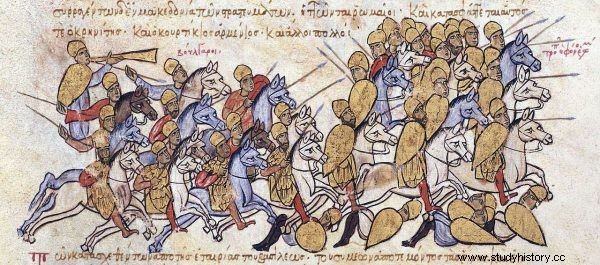The Byzantines called themselves "Romans" throughout their empire. They believed that after the fall of the Eternal City, the center of the empire moved to Constantinople. In some respects, however, they did not live up to the heels of their predecessors - or so a Byzantineologist suggests.
To this day, the Roman army is a model of an efficient and effective military organization for many people. Perfectly functioning legions are inextricably linked with the empire and have become one of the foundations of its power.
When the Western Roman Empire collapsed and Constantinople took over the culture-forming role of the Eternal City, it seemed that the East would continue the glorious military tradition. Indeed, as in the book "The Byzantine Wars. Strategy, tactics, campaigns ” underlines the professor of Byzantine studies at Princeton University, John Haldon, successive rulers understood the importance of military affairs:
Throughout the history of the empire, military issues were of fundamental importance to him, so it is no wonder that a large proportion of the state's annual income was allocated to the military and related matters.
Impassable roads and lazy sieges
However, the same researcher also points out that in practice the Byzantine army was only a shadow of the former power. How it's possible? Well, as Haldon reports, the difficulties arose at the most basic level. Byzantine troops were not able to use the perfect road network which is Rome's showpiece:
There is no doubt that the Roman army owed its effectiveness and combat prowess to a network of military roads, mostly built between 100 BC and 100 AD. (...). For a variety of reasons, regular road maintenance ... in the Late Roman Period, it seems, was severely neglected .

The Byzantines have had more than one losing battle.
The professor says that although the routes were repaired on a regular basis, the routes in more distant provinces were sometimes forgotten. As a result, the condition of some episodes was downright disastrous. "(...) skimpy evidence suggests that many of them have almost turned into paths suitable only for pack animals , with paved or paved surfaces only near cities and fortresses, "writes Haldon.
Moreover, commanders from Constantinople reluctantly, it seems, also used the technical achievements of their predecessors. "Despite the Byzantine reference to ancient traditions, Eastern Roman siege art was not particularly sophisticated" - convinces the Byzantineologist. Though machines were occasionally used to conquer besieged cities, Byzantine soldiers were much more likely to… just waited, trying to starve their enemies. It also happened that they tried to undermine themselves - these two strategies definitely outweighed the classic assault.
The professor goes so far as to question the information about the use of siege machines in period sources. As he claims, these entries could only be found there because of a literary convention! Ancient documents were rumored to have been eagerly plagiarized by Byzantine authors. "For example, the account of historian Leon Deacon (10th century) of the siege of the Muslim fortress of Chandaks in Crete is taken directly from a similar description of the siege in Agathias (6th century)," notes Haldon.
Lack of "non-commissioned officers"
However, the professor's greatest accusation against the Eastern Roman armies is their "dependence on competent and intelligent leadership." Well, in his opinion, "the quality of the commander-in-chiefs was one of the most important aspects of the Byzantine wars." Why? As he explains:
Unlike the 1st and 2nd century Roman legions, for example, the Byzantine armies did not have a reliable, proven, self-aware "NCO" , capable of discipline and managing individual units and sub-units, often compensating in tactical situations for the shortcomings of senior officers. The quality of the command was therefore decisive, as everything depended on the attitude of the commander-in-chief, from morale and discipline to efficient logistics.

The curiosity was based, among others, on the book by John Halton "Wars of the Byzantines. Strategy, tactics, campaigns ” (Rebis 2019).
The lack of consistent command, which was usually accompanied by low morale of soldiers, sometimes even led to absurdities. This was the case, for example, in 813 near Wersinikia, when part of the army, bored with a long stop ... threw herself into the fight . "The Macedonian strategos lost his patience and sent the emperor a message that he did not intend to delay any longer, he was launching the attack and expecting the center and the second wing to follow his footsteps" - says the author of "Byzantine Wars" .
How then can we explain that the Byzantine Empire survived for almost a thousand years? Even though they were "embarrassingly ineptly commanded," Haldon says, the Eastern Roman armies still had an advantage over enemy forces, which usually lacked even basic organization. Therefore, he does not condemn the Byzantine army in czambuł - but does not hide that it was far from the Roman army ...
Source:
Trivia is the essence of our website. Short materials devoted to interesting anecdotes, surprising details from the past, strange news from the old press. Reading that will take you no more than 3 minutes, based on single sources. This particular material is based on the book:
- John Haldon, The Byzantine Wars. Strategy, tactics, campaigns , Rebis 2019.
Buy the book cheaper on Empik's website:

